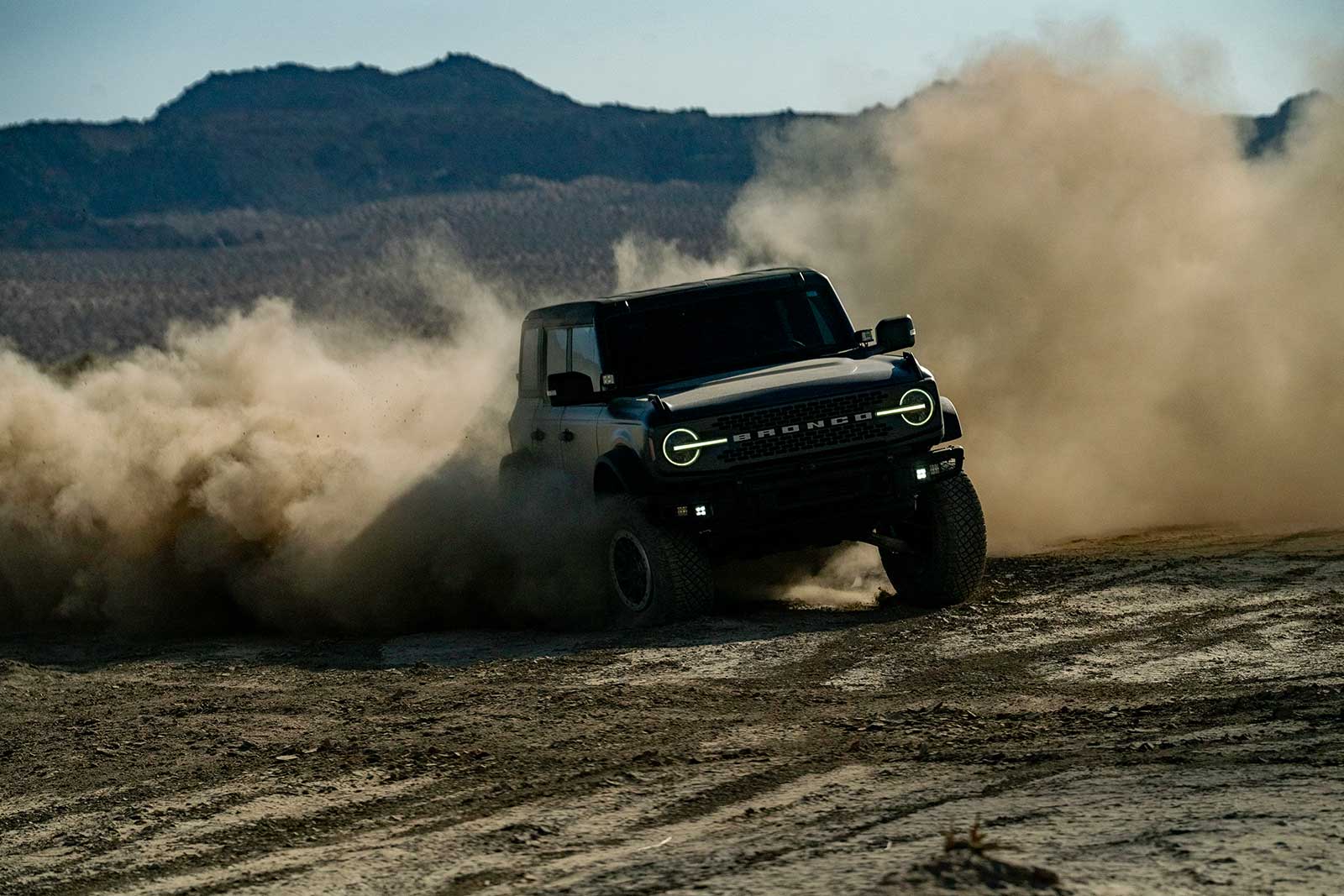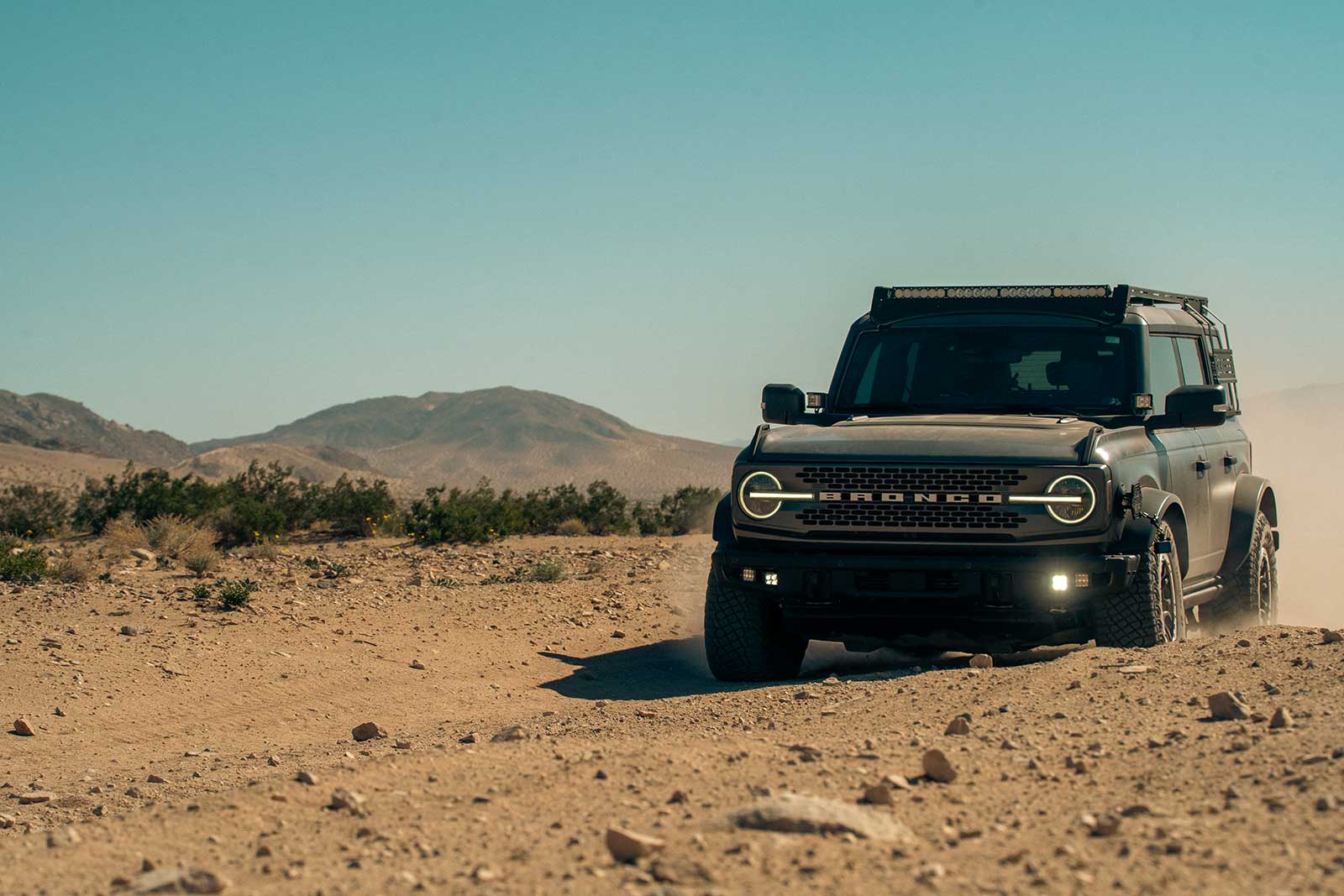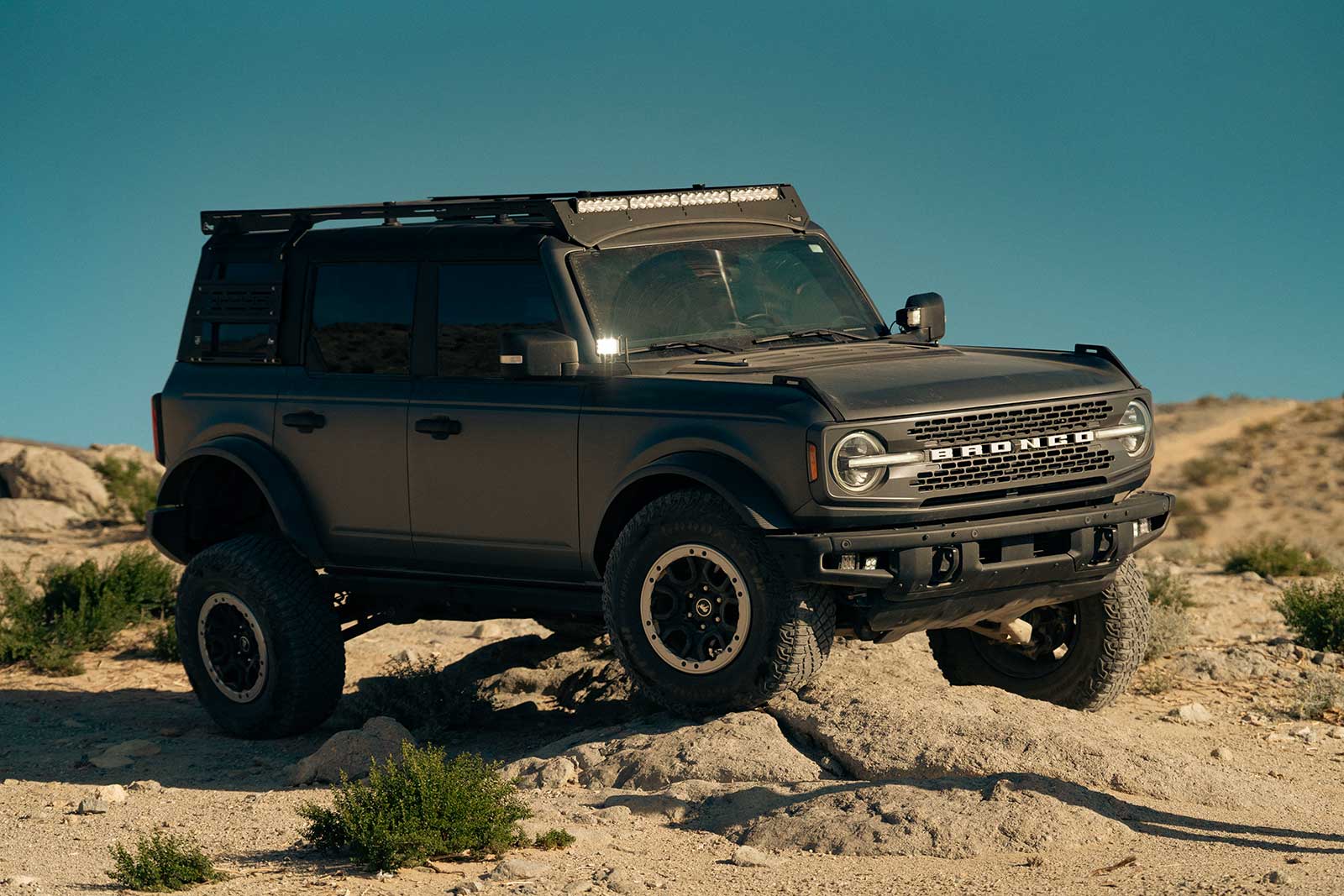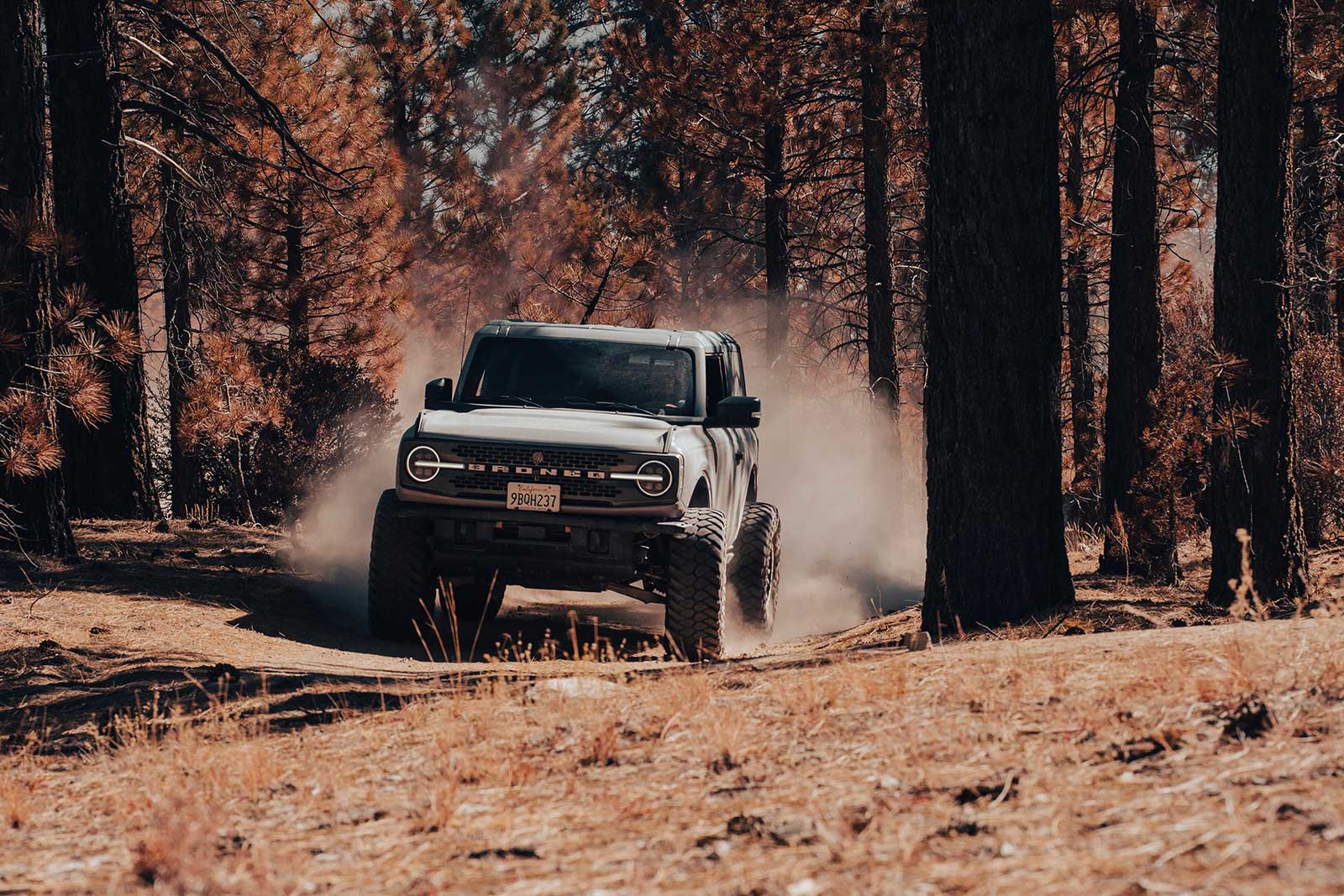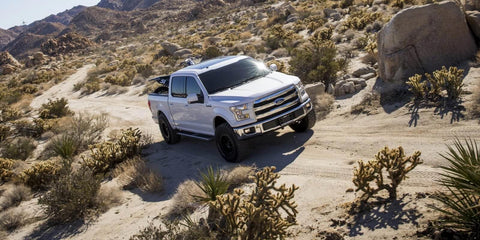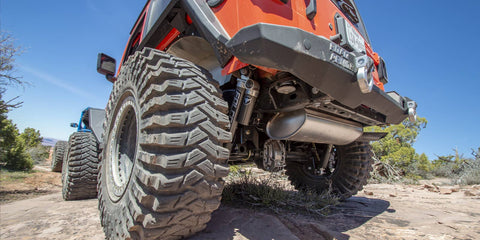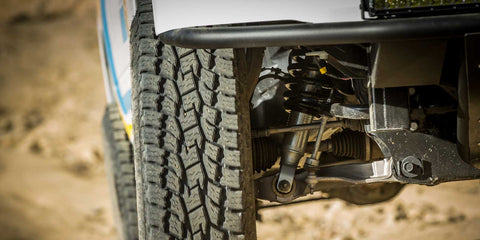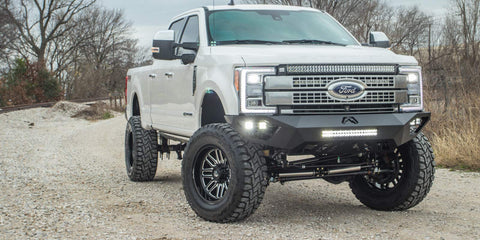Fox Performance Elite & King Shocks on the 21+ Ford Bronco
Posted by Sean Law-Bowman on
Introduction
In This Article
As always, here at Shock Surplus, we have to test things ourselves before we can give out our seal of approval. However, with the gravity of such a highly requested shock showdown, we decided to take a slightly different approach to our testing in hopes of giving the growing number of Bronco buyers the insight they need to make the right choice for them.
A Tale of Two Broncos
Many of you have likely become accustomed to us almost strictly delivering the punishment when it comes to shock testing, especially with this ongoing Bronco series, so it was time to add a slightly different perspective and Bronco to the mix. Enter Griffin and the incredibly talented team at Vision Creative Co with their nearly factory-fresh Sasquatch 4 Door with the mightier 2.7 V6. Where our little two-door 2.3 is treated more like a toy that gets hucked around the desert and dragged up rocks at the behest of the already tired clutch, the Vision machine is almost strictly a tool designed to transport camera gear, get to remote sites for shoots, and most importantly as an off-road camera car. Not only is this likely the first 6G Bronco to feature a Motocrane setup attached to the roof, it has been responsible for most of the footage you see of APGs Pro Runner Broncos. That means it needs to be able to glide over uneven terrain to get the smoothest shots possible, while keeping up with some of the baddest Broncos on the planet.
Testing began with each coilover going to their initial Broncos, with the Fox staying close to home with our plucky two-door while the Kings worked full-time under Vision’s care. This was not done gratuitously, though, as we knew the drivers, and we are very familiar with the tuning ethos of both Fox and King. Where you can bank on King comfort and you can never count out the control of a Fox, these shocks go about attempting to achieve a similar level of performance in their own unique ways. The goal was to do a swap after initial testing, but ironically, we likely got it right on the first try, and you will see why.
Adjuster Designs
Right off the bat, you can really get a feel for the “personality” of each of these shocks just by looking at their adjuster designs. The Kings use a single-speed compression adjuster that has 24 total clicks. Although the first 4 clicks mostly control low-speed compression, the remaining 20 clicks have nearly equal effect on the whole range of compression. This means after those first initial clicks, any adjustments made to alter the ride will also affect handling and vice versa. That said, this also makes them fairly easy to dial in, which is critical when on a video shoot and every second counts or if you simply do not feel like putting on a suspension engineer hat every time your tires touch a new surface.
The Fox has a much more complex clicker design that features individual adjustment for low-speed and high-speed compression. This means you can really lock down unwanted body roll, brake dive, and squat with your low-speed knob and the majority of your bump stiffness with the high-speed knob. You may notice a little degradation in small bump sensitivity as you get to the higher low-speed compression settings, and it can easily bottom out at the lower high-speed compression settings, but with 10 clicks of low speed and 12 clicks of high-speed compression adjustment, there is plenty of room to play around with both before you get to the extremes of either. Our primary Bronco pilot is a masochist with an expired Pro Am Formula Drift license, so you can be certain we have the low speed maxed out even if it does make the ride slightly more harsh.
Measure Up
Compression adjusters aside, the physical dimensions of these shocks also played a huge factor in each shock finding their respective homes. If you have taken the time to research the compressed, extended, and stroke lengths of both, you probably have been surprised by just how limited in travel the Fox coilovers are. Fox intentionally built their coilovers in a way that purposely restricts upward suspension travel to guarantee your stock fenders and flares are safe from a big 37” tall tire. While also ensuring the coilovers are not too long when fully extended to avoid any chance of CV bind.
The Kings are certainly shorter, fully compressed, and longer fully extended, so they cycle significantly more travel at the expense of some tire clearance and the slightest bit of CV bind. You can still get away with a 37” tire with the Kings; however, they will hit at full bump, so your fenders are definitely in danger if you like to huck your rig. The CVs will also bind ever so slightly at full extension with the steering turned all the way to the lock stops, which is something to be aware of if you plan on doing any serious wheeling with these coilovers. If your front end is unloaded while you are in 4WD just keep it a few degrees off full lock, and you will be fine.
Our Bronco is already on a big set of Maxxis tires, while the Vision four-door was still on the stock Sasquatch 315s, so we figured we’d give Griffin the travel of the Kings, and we can try to save what's left of our two-door fenders with the Fox setup. Plus, it is unlikely the Visionmobile will see full lock, full droop, and front diff lock all at once often, if at all, so CV bind is not all that much of a concern. Outside of our test days, that Bronco will not be flying through the air much, so even if 37s are in the cards, those fenders should be safe as well. However, if you plan to cosplay as Loren Healy on big tires with the Kings, a slightly longer bump stop, trimming, or aftermarket fenders will guarantee you will not blow body panels apart when you fly first-class Bronco Air.
Material Matters
Another point of contention was their construction, with the Fox being made of an anodized 6061 T6 Aluminum and the King using a more traditional zinc-plated steel body. Where the Fox will be largely corrosion-free for the foreseeable future, it will require a spring compressor to make preload adjustments, which would not be ideal for the Vision 4 door. We really do not care about the lift height on our two-door, and carrying weight will never be a concern, the same could not be said for our 4 door counterpart.
Although not overly specific on unloaded ride height, with the number of different camera rig setups that will be attached to this Bronco, it is a really nice luxury to be able to make quick adjustments with the coilovers still installed to make sure everything was riding level for the best shots possible. Rust will definitely be prevalent eventually, but their ease of adjustment outweighs their propensity for corrosion for that particular application. Otherwise, if the last thing you want is rust on your four-figure suspension system, the aluminum body Fox coilovers are definitely the way to go. Just remember, you will need a spring compressor if you want to change height or preload.
Spring for the Upgrade
Both brands go about springing their respective coilovers very differently as well. Although both are 2.5” body threaded coilovers, Fox opted to go with a 3.75” ID (inner diameter) coil front and rear compared to the more typical 3.0” ID coil used by King. This allows Fox to use the same spring for both the 2.5s and 3.0s, but there is no question that 3.0” ID springs are more readily available than 3.75s.
Both brands have deemed the rear end of these Broncos necessitates a dual-rate spring setup; the Kings we received use a dual spring and slider setup while Fox uses a single progressive coil spring.
The single progressive spring design of the Fox will certainly have the capacity to be more effective, make less noise, and require less maintenance, but also means if your rig starts to run heavy out back, you do not have that many ideal options when swapping in a stiffer spring. A 3.75” progressive coil in the right length and a different rate pretty much does not exist, so if you are building something heavy, the King might be the better choice, even if the off the shelf valving is a touch soft. A couple of stiffer options are available for both the primary and secondary 3.0” ID coils for the rear Kings, and there are many more options for 3.0” ID coils for the front, so it will likely be much easier to set them up for more weight to a point. With that said Fox comes with a stiffer set of springs and plenty of preload adjustment, so they can take a fair amount of additional weight out of the box, which we can not say for the Kings.
Installation Considerations
The one place where both really are not too dissimilar from each other is when it comes to installation. Both go together and bolt on very easily, and they are really no different from any other coilover kit for your Bronco. Both should really be paired with an aftermarket upper control arm on the front and to get all the articulation they provide, you will need to upgrade your rear links. With that said, all you really lose out on is some extra flex if you decide to keep your stock rear trailing arms and track bar, so you do not have to upgrade immediately if you do not want to. Both Broncos have been rolling with stock links for a while with no complaints from the drivers or the rigs.
The only installation avenues where they really differ are reservoir placement in the front, and out-of-the-box lift heights or, in the case of the King, lack thereof. As standard, the King reservoirs mount to the forwardmost crash bar/body mount right in the way of the tire. The stock Sasquatch 315s were not an issue, but our two-door has rubbed the paint off the exact spot where that reservoir mounts, so if you are running a 37” or larger tire like we are, you might need to find somewhere else to mount the reservoir.
Fox mounts their front reservoirs just aft of the shock tower on the frame parallel to the ground. This requires you to trim your front liners and introduces the reservoirs, namely the adjusters, to some fairly high engine bay temperatures. In our testing, we did not notice any appreciable fade, but the adjuster on the passenger side did freeze right after a fairly hectic run through the whoops.
Being a 2.3, the one and only turbo is on that side, meaning that the reservoir is exposed to much more heat than any other corner, leading us to believe that was the cause for the stuck adjuster. Between the heat from the engine bay, how much effort they take to turn, and how sharp their edges are, they make excellent fingerprint removers after a long day in the desert, even when they are not stuck.
However, they are free and clear of a big tire, so although a pain point in the literal sense, we think this is a better location overall. Just keep a rag or a pair of gloves handy when you want to make a few adjustments after a long drive. Some sort of heat shield would also be worth its weight in gold as well, and is likely a solution we will be looking to, to save our delicate mitts.
Lift Heights
Their respective lift heights, or how far apart they were, were what really surprised us. Out of the box, the King 2.5s gave almost no lift whatsoever, and a full cooler and groceries were enough to drop the rear of the four-door below stock height. Luckily, as we said previously, they are quick and easy to adjust while installed. Eventually, we were able to get the front and the rear up to around 1-1.5” of lift over normal Sasquatch height, even with the little additional constant load. A two-door like our Bronco would definitely sit a bit higher, but if you go for the Kings, do not expect to get a ton of lift without adjusting them, and be prepared to change out those rear springs if you have any serious amount of constant load. With that said, if you need to change the springs or add a little preload, King makes it a lot easier with their linear 3.0” ID coils and steel body.
Where the King offered little to no lift out of the box, the Fox gave us every bit of 3.5” of lift in the front and 2” in the back. It is quoted at 2.5” on two door Sasquatch models, but our two door probably had an extra 175 lbs of Casio keyboards, recovery gear, Maxxis MTs, and tailgate reinforcement so we are pretty sure those numbers are fairly accurate if it was empty and still had the stock spare. There is plenty of preload adjustment to offset more constant load, and we have had more than one customer adjust them to as little as around 1.5” of lift all around, with the only real limitation being that the adjustment collar gets pretty darn close to the reservoir fittings.
Although we would probably drop preload a little bit to minimize how often they top out up front if we were keeping these for the foreseeable future, their long compressed length does mean they are a little happier with more lift so you maintain as much bump travel as possible. Basically, if you want to keep lift minimal, these may not be the coilovers for you, but if you want as much height as makes sense, the Fox Performance Elite Series coilovers might be more your style.
Street Ride Quality
Although Fox and King are synonymous with off-road performance, the harsh reality is the vast majority of these coilovers will see more road miles than trail miles. Even if your Bronco is free of the toils of daily driver duty, you likely turn more miles driving to your local trail center than you do on the trails themselves. Whether we like to admit it or not, on-road comfort and stability are arguably just as important as off-piste performance.
We are happy to report that ride and handling in most situations is better than the stock Bilsteins on both of these packages. They are more consistent and predictable and transmit less road harshness, so you can be confident your commute will not get any worse by installing either of these kits.
Cushy, as always, the Kings offered a level of comfort that we just could not match with the Fox, regardless of settings. They transmitted less road harshness, never let you know when their bump stops were engaged, and generally were a lot kinder to our spines and dental work. They did have a little bit of a wiggle on rebound at higher speeds and a propensity for more sway and dive than we would deem ideal. Adding a few clicks to stiffen them up on compression certainly helped minimize the unwanted body motions, albeit at the expense of some of the comfort that makes these Kings so good. In the end, we settled on keeping the Cadillac ride, and simply living with the small amount of remaining body roll.
We would not compare the Fox to a Cadillac like we can with the Kings, but we would not call them uncomfortable either. We will not sugarcoat the fact that they definitely feel firm enough to let you know the exact shape, size, and profile of many of the more minor imperfections in the road, and due to their long compressed length and small bump stops can still bottom out pretty hard especially if you have the high-speed compression set up too soft, but even with their faults they are still much more livable than the stock Bilstein ESCVs.
Where the Fox really starts to shine brighter than the Kings is how tight, predictable, and confidence-inspiring they are around corners and anywhere where stability matters. With the low-speed compression at full stiff, we have found ourselves treating our tall, short-wheel base, Bronco, like a sports car in traffic. Simply put, you will lose traction before the suspension wiggle sends you off line, which is no small feat, especially with so much lift and rubber working against them.
Off-Road Performance
Off the road or in low grip scenarios, the additional adjustment and overall tighter handling of the Fox definitely makes driving at or beyond the limit a breeze. We found right away that the Bronco was the most fun with the LSC (Low Speed Compression) adjusters at full stiff, which kept unwanted sway to a minimum and even gave it a tendency towards enough oversteer to play around just how we like. At the limit, the rear would gently step out in a very progressive and manageable way, and if you push even further, the front would start to scrub giving you plenty of warning to back it down a bit. In fact, this Bronco was easier to slide around in the dirt than many of the “drift cars” we have had the keys to over the years.
That is not to say the Kings are unstable by any means. In fact, for the most part, they are very predictable and confidence-inspiring, but their more plush tuning and lack of independent low speed compression adjustment leaves them a step behind the Fox in the handling department. Their additional roll and dive could help maximize traction where it is minimal, but there certainly was some unwanted wiggle, especially during direction changes at speed. At the limit, it seems this additional “looseness,” and their general lack of low-speed compression means the limit comes up a little more abruptly. Once you have exceeded the limit of traction, the front gives first, making understeer more common than oversteer. Admittedly, understeering is a much safer outcome for the inexperienced driver and can also sometimes help you exit a corner with more speed; it doesn’t feel good or fun. Obviously, you can play with the adjusters to get a more neutral balance, but it does not seem that you can eliminate their pushy tendencies completely and often comes at the expense of ride quality and the balance of bump support front to rear.
We know limit handling is not something many of you care about or would ever become a serious concern; however, one thing most of us Bronco owners will have to deal with is the ride quality at reasonable speeds off-road and especially on the trail. Whether you are putting down a corrugated forest road to your local campsite or crawling over hard obstacles, we are happy to report both are a marked improvement over the stockers without a doubt. Whereas we rattled fillings loose, praying our campsites were just around the next corner with the OEM HOSS 2.0 suspension, both the Fox and the King offered rides we could happily live with all day long. Just like on the road, the King was undoubtedly the more comfortable choice, especially on washboard roads and other chattery surfaces. We were most happy with them about 6-12 clicks in from full soft, which gave the Bronco a very forgiving ride that still had the support to keep us off the bump stops without having to slow down when a rock or rut found its way into our path.
As things grew more technical, and we found ourselves on a real trail with real obstacles, the additional travel, and soft springs made the Kings flex like a champ, even with independent front suspension. The Fox coilovers delivered on their usual firmness out in the woods, just like they did on the road, but they were still plush enough to keep you sane. Their saving grace once again comes by way of their Dual Speed Compression adjusters, allowing them to be easily optimized for most any scenario. When we found ourselves needing all the flex our little Bronco could muster, we were able to go full soft on LSC and about 8-10 clicks in on HSC so that we had the most articulation and traction we could get while still having the support to bump our way up a tough obstacle if we had to. The rear certainly did not articulate as well as the Kings since these Fox 2.5s are short on travel, but the ability to back off LSC did have the front end working pretty darn good. In short, the Kings might still take the crown in this department, but the Fox is not far off. Additionally, as speeds increase, a winner gets even harder to choose.
Whoops We Did It Again
Broncos and Baja have a history that has long been intertwined, so we could not get through this test without smacking some whoops and floating some rollers out in the California sand. Both brands have countless race wins in just about every series under the sun, so we had a feeling they were going to be good, and well, they were. We had a strong inkling both the Fox and the King would offer similar all-out performance as well, but we were baffled by how differently they went about tuning their way to podium-level prowess.
The incredibly linear and plush valving of the King, matched with their longer, more progressive, and supportive bump stops and additional travel meant they could really party if you have the faith in them to keep it pinned—the key phrase there being if you have the faith to keep the pedal down. More so than just about any system we have run so far, there are a lot of hits that will send you to your bump stops at medium to moderate speeds that you can skim over like they are not there at higher speeds.
This means there are almost two “limits” with this suspension, with a fairly gross divide in speed between the two, making the driving style required to get the most out of the suspension anything but intuitive. It is very much like having a digressive shock where faster is better, but instead of softening up with speed, they offer more support. Inexperienced drivers might have a hard time extracting all of the capability of this setup, simply because you can not progressively work your way up to the true limit. Instead, you have to take a leap of faith, keep it pinned, and believe your Bronco can take it. With that said, if you have the pebbles to push it that far, we do think you might be able to pass a Fox-equipped Bronco through the same section. It might just take a more experienced driver to get there comfortably.
Right out of the gate, we were incredibly let down by the piddly excuse for bump stops that Fox specced these shocks with, but their added mid-speed compression support allows the driver to push them to their limit more progressively. If pushed too hard, they will slam to full bump much more easily than the King, but since they are much more supportive at more moderate speeds, you can slowly and progressively work your way up and beyond the efficiency zone. Simply put, they are easier to drive fast, especially if you are new to the dirt boogie.
If a hot shoe could hold 55 mph through a section with the Kings, and a newb might be tapping out at 40 mph, anybody with functioning limbs and eyeballs could drive a Fox-equipped rig 45-50 mph, wheelman or not. The Fox also seems to have more active low-speed rebound characteristics, making it more responsive to throttle input and, therefore, potentially better in situations where you have to “2 stroke” your way through a section or use throttle input to shift load from front to rear to skim your way through a section you would normally have to slow down for. As in other areas, their limited travel and lousy bump stops let these shocks down, but a bump stop upgrade is cheap, easy, and could certainly put these a point or two ahead of the Kings when pounding at speed.
The Verdict
So who is the real winner? It is the lucky few Bronco owners looking at these kits because, as far as we can see, there really is no wrong answer for anybody. Are they perfect? Heck no, but we do think, as with everything, there is a right shock for the right person. If comfort is key, you prefer to keep your lift low, or you might be adding crazy amounts of weight then the King might be your kit. They are more than a step ahead of the Fox in the comfort department, and the springs they use can be much more easily swapped for something stiffer. They have a shorter compressed length and are not set up for much lift out of the box, so they are much happier when set closer to stock height. You will need to do some tweaking, trimming, or bump stop spacing if you want to clear 37s, but the average person should be able to throw a set on and be perfectly fine as long as they keep all four tires on the ground and move the reservoir mounts. Otherwise, if handling prowess, a higher lift height, and more approachable high-speed performance are paramount to you, grab the Fox and upgrade the bump stops. Not only will this give you similar support to the Kings when you are full-tilt in the dirt, but it will also allow you to run softer high-speed compression everywhere, which should net you a little more ride comfort. Furthermore, if you have 37s, these Fox coilovers will ensure trimming can be kept to a minimum, and in most cases, you will be able to keep your stock fenders and flares totally intact.
Future Bronco Plans
Up next, we are looking to try shocks like the Icon 2.5 CDCV and CDEV, Fox 3.0s, and the highly requested Dobinsons MRR 3 Way adjustable shocks, but rest assured if somebody makes a set of shocks for your Bronco, we will get our hands on it for thorough testing and more ride reviews. Keep it locked because, as always, we have much more Bronco shenanigans coming your way.
























